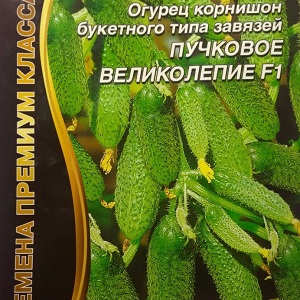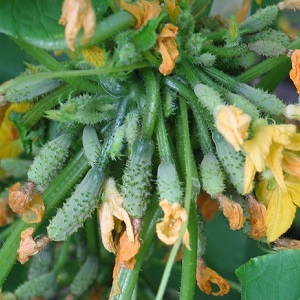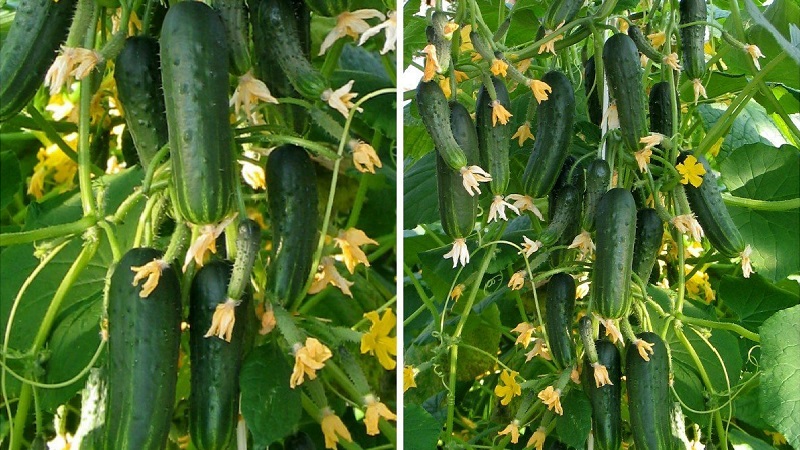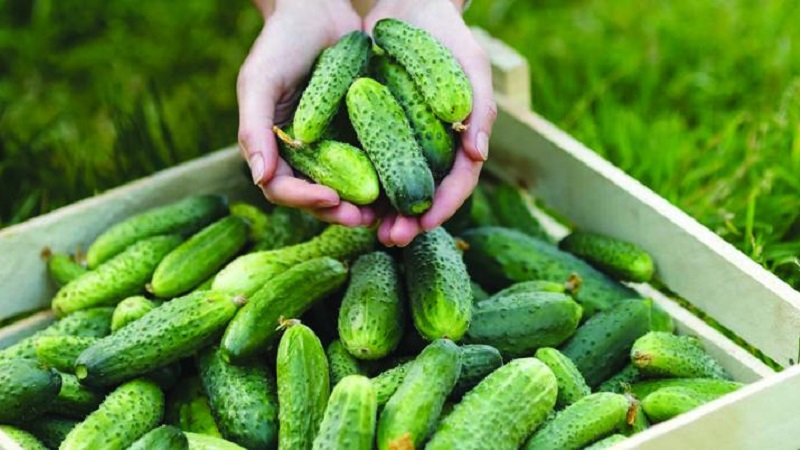Cucumber hybrid "Bunch splendor F1": growing gherkins in a greenhouse, open field and on a windowsill
To grow hybrids correctly, you need to study their specifics. The article will focus on the F1 hybrid sheaf splendor, bred by the Ural breeders. You will learn what are the features of caring for him and how to use the resulting crop.
The content of the article
Description of the hybrid
Cucumbers Sheaf splendor refers to gherkins. They are grown in the open field, in greenhouses, as well as on the windowsill in an ordinary pot.
Suitable for cultivation in Siberia and the Urals.
Distinctive features
A hybrid has a lot of advantages:
- resistance to temperature extremes;
- the ability to grow in low-lying areas with increased nebula;
- resistance to more common cucumber diseases;
- fruiting until autumn, even with frost;
- high productivity from a bush.

Composition, properties, benefits, calories
Composition of cucumbers-hybrids Bundle splendor F1: 95% water, carbohydrates, sugars, dietary fiber, ash, vitamins and minerals. Caloric content of 14 kcal per 100 g. Fruits are sweet and juicy.
Fruit consumed fresh and canned... Due to the miniature size of gherkins and their taste, they are mainly used for conservation. The sizes of fruits from one bush are the same.
Due to the increased content of potassium in fruits note the benefits of fruits for the work of the heart and kidneys... Fresh consumption of cucumbers has a urinary and diaphoretic effect.
Fruit have a choleretic and mild laxative effect... Cucumber juice relieves eyelid fatigue: in case of redness and swelling, cucumber slices are placed on them or lotions are made with its juice.
Hybrid characteristics
 The yield of cucumber Bunch splendor F1, declared by manufacturers, reaches 40 kg from 1 bush... This is achieved due to the formation of a large number of fruits in 1 bunch: the number ranges from 3 to 7 ovaries at a time.
The yield of cucumber Bunch splendor F1, declared by manufacturers, reaches 40 kg from 1 bush... This is achieved due to the formation of a large number of fruits in 1 bunch: the number ranges from 3 to 7 ovaries at a time.
All ovaries in 1 bunch are fruiting, since they are female... Pollination does not require the participation of insects or humans, the flowers are self-pollinated. The hybrid was bred by the Ural breeders for cultivation in the climatic conditions of the Urals and Siberia.
The hybrid also tolerates hot, arid climates... But cucumbers of this type are finicky to care for and require timely watering, weeding and application of mineral fertilizers. To obtain a rich harvest during the growth of the bush, it must be shaped and tied up.
The hybrid is classified as a cucumber gherkin type, therefore, do not expect large fruits. In length, the cucumber reaches no more than 11 cm.
Attention! For cultivation for seeds, Bunch splendor is not used, since only the first generation hybrid has perfect qualities.
How to grow yourself
The culture is early maturing, harvesting is planned for 45-50 days after planting seeds. For planting in open or protected ground, there are two options: seeds or seedlings.
Planting by seed and seedling method
If you decide to plant seeds in the ground, they need to be prepared.
For disinfection, a solution of manganese or saline is used, in which the seeds are immersed for 30-40 minutes. For germination, the seeds are spread on damp gauze, folded in half, and covered with the same piece.The prepared raw materials are placed in polyethylene for 2 days in a warm place, after which you can see the sprouts.
Attention! Hybrid seed is often labeled with factory seed disinfection. Such grains do not need to be disinfected.
With the seedling method sprouted seeds are planted in small containers. Plastic cups filled with nutrient soil will do. A hole in the ground is made 2-3 cm deep.
The containers are covered with foil and wait for the first leaves. As soon as they have risen, the protection is removed, watering and spraying begin. When full-fledged 3-4 leaves appear, seedlings can be planted in the ground.
About other varieties and hybrids of cucumber:
Hybrid "Garland", which will delight you with a rich harvest
Growing in stages and care
 After planting the plants in the ground in a permanent place, regular care begins.
After planting the plants in the ground in a permanent place, regular care begins.
Form a bush, starting from the moment the ovaries appear... First, in the lower 3-4 sinuses, shoots are removed along with the ovaries. Further, all shoots and whips are constantly cut off during the growth process.
Mineral and nitrogen fertilizers are applied every 2 weeks... The plant needs regular support throughout the entire fruiting period, since this is the most energy-intensive time for cucumbers. With each fertilization, it is necessary to water the cucumbers abundantly to enhance the effect.
Features of cultivation and possible difficulties
The most common difficulty in growing cucumbers is the F1 cluster splendor - increased need for fertilizers... Before planting, 2/3 of the total volume of the allocated area for cultivation are filled with mineral fertilizers.
In addition to making a large amount of top dressing in the period before planting, it is necessary to constantly add it during growth. However, even with such increased requirements for the hybrid, there is a risk of introducing an excess amount of nutrients.
Another difficulty concerns the formation of the bush and its garter. For the garter, the twine is fixed on the trellis and only then the cucumber is wrapped around it. It is best to cut off the twine with a margin, so as not to wrap the bush too tightly in the future.
Typical diseases and pests, resistance
Cucumbers F1 beam splendor protected from numerous diseases and pests at the genetic level. However, diseases are not 100% excluded. With high humidity in the summer, the hybrid can infect anthracnose when the leaves become dry and the shoots become covered with ulcers.
White rot is another common disease in the hybrid... It begins with high humidity. The stem affects a slimy coating, the cucumbers become covered with white rot.
The same developmental features have gray rot, but it occurs with sudden temperature changes. Since the hybrid is resistant to temperature fluctuations, gray rot disease is rare.
Among insectsattacking the plant, note aphids, whitefly and spider mites. They suck out the juices of the plant, slowing down its growth and damaging the fruit. Pest control is standard - garlic and onion infusion, spraying with insecticides for severe infestation.

Harvesting and application of the crop
Beam splendor yields quickly even in places where cucumbers have already been harvested... In connection with this feature, the harvest from the bushes is harvested at least once every 2 days.
Fruit use varies according to preference. Sweet and juicy cucumbers of this type are eaten fresh. The size and uniform shape of the fruits make them indispensable for canning and salting.
Advantages and disadvantages
A hybrid has many advantages... Cucumbers are early, and harvesting can take place until late autumn, especially in warm regions.
Cucumbers have high yields and are protected from most known diseases... They have excellent taste characteristics and are good in preservation.They can be planted under any temperature conditions in open and closed ground.
The disadvantages include the need for frequent fertilization in large quantities, which implies additional costs. Sometimes the disadvantages include frequent harvesting.
Reference! If the assembly schedule is not followed, the bush reduces the fruiting rates, while the quality of the fruit deteriorates.
Consumer reviews
The results of planting a hybrid Beam splendor among gardeners are different: the culture needs full care.

Antonina, Moscow: “Cucumbers I have been planting sheaf splendor for several years now. At first, a friend of mine just recommended them to me, she sent me a photo of a big harvest. I purchased 2 bags of seeds per sample, followed the planting recommendations a little incorrectly and did not germinate the seeds before planting. As a result, only 4 bushes grew out of 8 seeds. I liked it in terms of yield, and it tastes good, so the next year I bought more and prepared more thoroughly. Now I'm salting not only for my own people, but also for sale ".
Olga, Rostov: “I tried to plant bunch cucumbers for the first time, so I immediately read all the recommendations on the Internet. It is difficult to grow them due to the constant demand for watering and fertilization. As soon as I got the first harvest, I was delighted, but I think that I will plant a little less for the next season, since there is nowhere to put them. I was glad that the cucumbers appeared quickly, at the beginning of summer they gathered the first crop ".
Valentina, Belgorod: “Cucumbers of such a plan are not suitable for country plantings, especially if you, like me, rarely go there. She planted several bushes, of which only two grew. I rarely applied fertilizers, and there was no time to follow the harvest. I got a very small volume. This year I decided to plant seeds in an apartment on the balcony, let's see what happens ".
Conclusion
High-yielding cucumbers Bundle splendor are perfect for gardeners who have the time and desire to follow a demanding crop. The quality and appearance of the grown gherkins will not leave indifferent housewives who appreciate crispy and even pickled or pickled cucumbers.